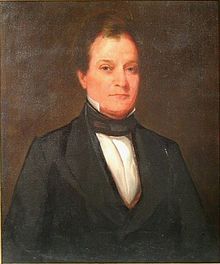
Back ويليام بي. كامبل Arabic ويليام بى. كامبل ARZ ویلیام بی. کامپبل AZB William B. Campbell German William B. Campbell Portuguese William B. Campbell Swedish Вільям Боуен Кемпбелл Ukrainian
William B. Campbell | |
|---|---|
 Portrait of Campbell by Washington B. Cooper | |
| 14th Governor of Tennessee | |
| In office October 16, 1851 – October 17, 1853 | |
| Preceded by | William Trousdale |
| Succeeded by | Andrew Johnson |
| Member of the U.S. House of Representatives from Tennessee's 5th district | |
| In office July 24, 1866 – March 3, 1867 | |
| Preceded by | Robert H. Hatton |
| Succeeded by | John Trimble |
| Member of the U.S. House of Representatives from Tennessee's 6th district | |
| In office March 4, 1837 – March 3, 1843 | |
| Preceded by | Balie Peyton |
| Succeeded by | Aaron V. Brown |
| Personal details | |
| Born | William Bowen Campbell February 1, 1807 Sumner County, Tennessee |
| Died | August 19, 1867 (aged 60) Lebanon, Tennessee |
| Resting place | Cedar Grove Cemetery (Lebanon, Tennessee) |
| Political party | Whig |
| Spouse | Frances Owen |
| Profession | Attorney |
| Military service | |
| Branch/service | Tennessee Militia United States Army |
| Years of service | 1836–1837 1846–1847 1862–1863 |
| Rank | |
| Commands | 1st Regiment Tennessee Volunteers |
| Battles/wars |
American Civil War |
William Bowen Campbell (February 1, 1807 – August 19, 1867) was an American politician and soldier. He served as the 14th governor of Tennessee from 1851 to 1853, and was the state's last Whig governor. He also served four terms in the United States House of Representatives, from 1837 to 1843, and from 1866 to 1867.[1]
During the Mexican–American War, Campbell commanded the First Regiment Tennessee Volunteers, known as the "Bloody First" for its high casualty rate.[2] At the outbreak of the American Civil War, Campbell opposed secession, and briefly served as a general in the Union Army.[1]
- ^ a b John Thweatt, "William Bowen Campbell," Tennessee Encyclopedia of History and Culture, 2009. Retrieved: 2 October 2012.
- ^ Phillip Langsdon, Tennessee: A Political History (Franklin, Tenn.: Hillsboro Press, 2000), p. 125.